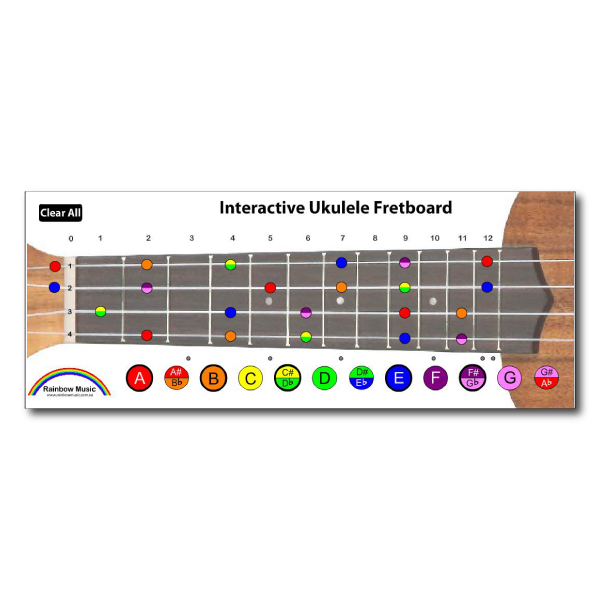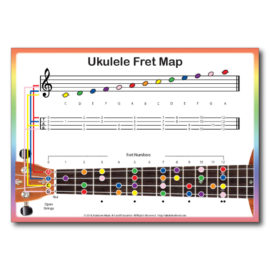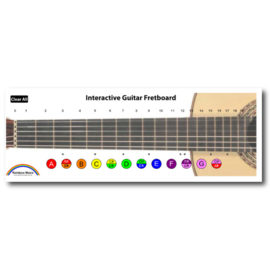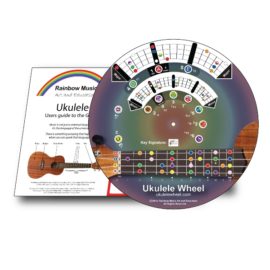Product Description
Find and play any or all Ukulele Chords!
Every different chord has its own unique pattern, for example all Major Chords include the 1st, 5th and 8th intervals.
What this means is you can start on any note in this example C and count.
(C = 1), C#, D, D#, (E = 5), F, F#, (G = 8)
Use the Interactive Ukulele Notes tool to turn on just these 3 notes, being the C Major Chord (C, E & G). The Interactive Ukulele Notes tool displays all playing positions for these notes. When these 3 notes are played at the same time, you will play a C Major Chord. Whereever you play these three notes on the Ukulele Neck the C Major Chord will be played, Grab your Uke and go exploring, see which C Major Chords variations you can find and play. Try anything you can reach and remember to use the Open Strings to make up your chords.
Above we have explored the C Major Chord, but we can do the same thing for any Major Chord using the interval count of 1-5-8. The G Major Chord is in the Key of C, so why not give the G Major Chord a go.
(G = 1), G#, A, A#, (B = 5), C, C#, (D = 8) G Major Chord (1-5-8) = G – B – D
Go ahead turn on these 3 notes (G – B – D) and see where all the G Major Chord Options are, play anything you can reach and again remember to use the open strings where possible.
Although in the above we have only looked at Major Chords, this same concept applies to Minor Chords, Suspended Chords, Diminished Chords in fact all chords. The difference is each chord type has it own unique interval count.
Here are the main ones.
| Suspended 2nd Chord | 1 – 3 – 8 |
| Diminished Chord | 1 – 4 – 7 |
| Minor Chord | 1 – 4 – 8 |
| Major Chord | 1 – 5 – 8 |
| Suspended 4th Chord | 1 – 6 – 8 |
Similarly with Ukulele Chords, each Ukulele Scale has a unique Interval Count, with the only thing changing is the starting note, also known as the Root or the Scale or Key.
Let’s look at the Major Scale, one of the most popular. There are a number of ways you can count out scales, either counting the intervals in between or simply counting the intervals
Here is an example of the Major Scale:
| 1 | 2 | 3 | 4 | 5 | 6 | 7 | 8 | 9 | 10 | 11 | 12 | 1 |
| 1 | 2 | 2 | 1 | 2 | 2 | 2 | 1 |
Simple Interval Count: 1 – 3 – 5 – 6 – 8 -10 – 12 – (back to 1)
Count the in between: 1 – 2 – 2 – 1 – 2 – 2 – 2 – (back to 1)
So this is the basic code for the Major Scale what we need to do now is apply a starting note of Root of the Scale, for this example let’s set the Root of the Scale to C, here’s what it looks like:
| (1) | 2 | 3 | 4 | 5 | 6 | 7 | 8 | 9 | 10 | 11 | 12 | (1) |
| (1) | 2 | 2 | 1 | 2 | 2 | 2 | (1) | |||||
| (C) | D | E | F | G | A | B | (C) |
Click on these notes to turn them on and have a look at how the C Major Scale looks on the Ukulele. You can apply this same count for any Root or Starting note with the Major Scale, here’s an example in A Major:
| (1) | 2 | 3 | 4 | 5 | 6 | 7 | 8 | 9 | 10 | 11 | 12 | (1) |
| (1) | 2 | 2 | 1 | 2 | 2 | 2 | (1) | |||||
| (A) | B | C# | D | E | F# | G# | (A) |
This same method applies to all Scales with only the count changing here’s some popular Scales to explore:
| Scale Name | Interval Count | In Between Count |
| Major Scale | 1-3-5-6-8-10-12-(1) | 1-2-2-1-2-2-2-(1) |
| Minor Scale | 1-3-4-6-8-9-11-(1) | 1-2-1-2-2-1-2-(2) |
| Pentatonic Major Scale | 1-3-5-8-10-(1) | 1-2-2-3-2-(3) |
| Pentatonic Minor Scale | 1-4-6-8-11-(1) | 1-3-2-2-3-(2) |
If you would like to isolate just a part of a Scale for practice, simply click the notes of the Ukulele Fret board to turn off the note you don’t want to see.





